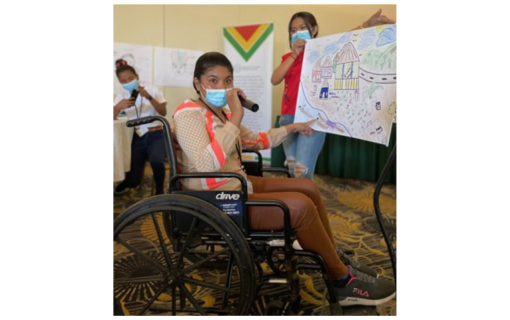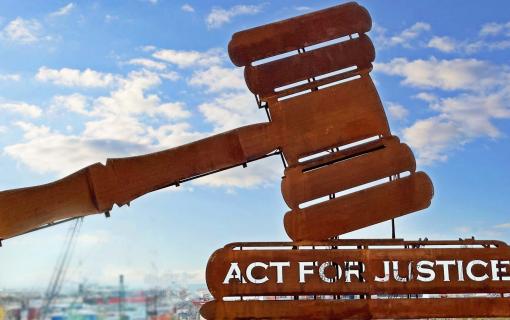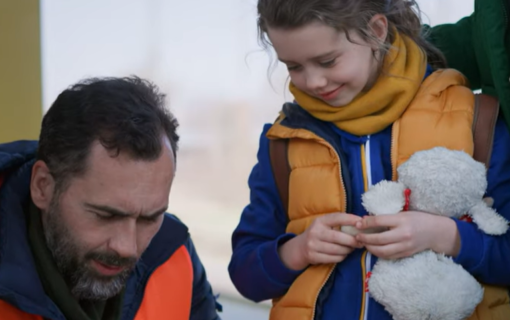IFES Alumna Focuses on Vulnerable Populations
Angela Peltzer helps manage the United States Department of Labor's Office of Child Labor, Forced Labor, and Human Trafficking's (OCFT) grant portfolio in Asia as International Relations Officer.
An IFES alum, she discusses the role of education, local government and the international community in mitigating the abuse of vulnerable populations. She also sheds light on what individuals around the world can do to promote more just labor conditions for all.
You currently help manage the Department of Labor's Office of Child Labor, Forced Labor, and Human Trafficking's (OCFT) grant portfolio in Asia. What countries do you focus on?
I have been fortunate to focus on a range of countries during my six years working with the Department of Labor. Currently, I am managing a project in Indonesia that is working to build the capacity of domestic workers’ organizations to promote decent work for domestic workers and reduce hazardous child domestic work. I am also very excited to be managing a new project we funded in December (2013) to reduce child labor in Burma.
OCFT was created by the U.S. Congress in 1993 to investigate and report on child labor. The mandate then extended to explore forced labor and human trafficking. How are these three issues related?
Worldwide, the International Labor Organization (ILO) estimates that there are 168 million child laborers, 85 million of whom work in hazardous conditions. The ILO has also produced global estimates placing the number of people trapped in forced labor at 21 million, including at least 6 million children in forced labor, including commercial sexual exploitation and debt bondage.
Many of these children are deprived of an education; get injured or sick at work; or face physical, emotional or sexual abuse by employers. The issues of child labor, forced labor and human trafficking are interconnected. The population that we work with – children working in the worst forms of labor – generally come from the most vulnerable populations within their countries. In some cases, these children are not only engaged in child labor, but have been trafficked into this work situation, may not be paid or have the ability to leave or return home, all of which are indicators of a forced labor situation.
As you can see, these issues can overlap. ILO Convention 182 on the Worst Forms of Child Labor also defines forced child labor and child trafficking as among the unconditional worst forms of child labor that all ratifying countries need to address as a matter of urgency. Additionally, in South Asia the issue of forced or bonded labor remains a significant problem. When the family is in a situation of bonded labor, it is very likely that the children will be as well.
What role does education or the lack thereof play in this area?
Access to a quality education plays a big part in preventing child labor. For this reason, it is an integral component of our grants. As you may know, children continue to face barriers to adequate education in many countries. Lack of access may be driven by many factors, including the absence of free public education; requirements to pay for books, uniforms, school fees and other school-related costs that prevent poor children from enrolling; inadequate education infrastructure; or poor quality instruction that contributes to perception in families that education is not worth the investment of their scarce resources.
Children who have limited or no access to educational opportunities are more likely to enter the workforce. Individuals who are denied educational opportunities in childhood face more restricted employment opportunities as adults, are more vulnerable to exploitation and their children are more likely to face the same challenges, contributing to a cycle of poverty.
Please tell us about the collaboration between the international community and local governments in addressing the exploitation of vulnerable populations. How much can the international community do without local support? And what does the international community bring to the table that local government cannot provide?
The international community plays an important role in addressing child labor. The international community, through the International Labor Organization (ILO), helps set international norms via ILO Conventions, to which ratifying countries are required to adhere. The two core ILO conventions that address child labor are ILO Convention 182 on the Worst Forms of Child Labor and ILO Convention 138 on the Minimum Age for Work. Our projects support the efforts of governments to comply with these international standards.
The international community and local governments are partners in the global campaign to end child labor. The international community helps by bringing financial and technical assistance to support efforts to address child labor, but it would not be possible for the international community to work effectively on this issue without local government support and buy-in.An example of this cooperation can be seen in the Global Conferences on Child Labor. In 2010, 400 representatives from 80 countries participated in the Hague Global Child Labor Conference, and together they formulated the Roadmap for Achieving the Elimination of the Worst Forms of Child Labor by 2016. The Roadmap calls on governments, social partners, civil society and international and regional organizations to work together to achieve the elimination of the worst forms of child labor by 2016. This past October, the international community convened again in Brazil to follow-up on the Roadmap and its progress. Governments from around the world and non-governmental organizations shared their successes and challenges in combatting child labor.
How can individuals around the world help mitigate these practices both in their own countries and around the world?
The first thing you can do is educate yourself by learning more about the different forms of child labor around the world. A good starting place would be visiting our 2012 Findings on the Worst Forms of Child Labor Report. I helped write this report, which contains narrative profiles of 144 countries and territories.
Second, you can learn more about how the goods you purchase are made and if there is the possibility that child labor was used in the production process. To do this, you can start by reviewing the List of Goods Produced by Child Labor or Forced Labor and the List of Products Produced by Forced or Indentured Child Labor This report covers 134 goods from 74 countries.
Finally, you can share the information you have learned with others. One way to do this is to organize an awareness raising event on the World Day Against Child Labor,which is held every year on June 12.
Lastly, what is your favorite memory from your time at IFES?
My favorite memory was traveling to India and Pakistan to visit two projects I had been backstopping for a year. The project in India was working to reduce violence against women in Rajasthan and Karnataka. While I was in India, I was able to spend a significant amount of time with our dedicated staff who run the program. More importantly, I got to meet and see the important work of our local partners. My memories of participating in a session on women’s Koranic and constitutional rights in Ajmer, visiting a women’s police station and laughing with team over our many lunches stay with me.
I am very proud to have had the privilege to work for IFES.









